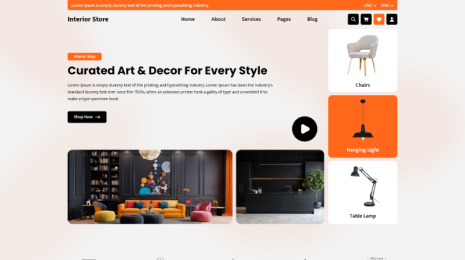
To obtain a dynamic change in the block’s structure whilst the consumer modifies a block, a state of a block is maintained through the modifying session as a simple JavaScript object. Every time a block is up to date the edit feature is called. In this blog, we will learn about attributes and components in Gutenberg blocks. Also, You will find the free WordPress themes on VWthemes.

Get Started With Attributes And Components In Gutenberg Blocks
To extract the JavaScript item once more from the stored content material of a publisher and reuse it we use the block type’s attribute property.
Attribute Sources
Attribute Sources assist you to extract block characteristic values from stored publish content material. They assist you to map from the stored markup to a JavaScript illustration of a block. If no characteristic supply is specified, the characteristic can be stored to (and study from) the block’s remark delimiter.
hpq: Attribute assets are a superset of capability provided through hpq, a small library used to parse and question HTML markup into an item shape.
- Attributes are nothing but objects in an array to the attributes property in registerBlockType(). Each characteristic’s keys the characteristic name, and also you have to have the property type as a minimum.
- The type property may be any of the following; null, boolean, object, array, number, string, or integer.
- You can optionally offer the property default to outline the beginning fee of your characteristic. If you don’t offer a default, the characteristic will default to null.
- Another characteristic property is supply that works collectively with the selector property, however, those are finicky matters that we’ll examine in element in addition down below.
There are various sorts of attribute sources you can use. For ex, attribute, text, HTML, query, meta and children.
Examples Of Different Attributes Components Gutenberg Blogs Are Source: 'Meta'
registerBlockType( 'myguten-block/test-block',
attributes: {
content: {
type: 'array',
source: 'children',
selector: 'p
},
},
When you will define these attributes into registerBlockType(), it gets passed to the edit() and save()
source: ‘children’ means it will look for the text inside of selector <p>
It is the way you use it in your edit function:
edit( props ) {
let { attributes , setAttributes, className } = props;
function onChange( event ) {
setAttributes( { author: event.target.value } );
}
return <p onChange={ onChange }/>{ attributes.content }</p>; },
Once it’s saved into the database, it can be taken out using props.attributes
save: ( props ) => {
console.log( 'save-props', props );
return (
<p>{ props.attributes.content } </p> );
}
Comment Delimiter
By storing statistics in HTML comments we might understand that we wouldn’t break the rest of the HTML in the document, that browsers need to ignore it, and that we should simplify our method to parse the document.
Let’s Create A Characteristic,
registerBlock Type( 'guten-block/test-block', {
title: 'Basic Example',
icon: 'smiley',
category: 'layout',
attributes: {
contentStyle: {
type: 'object',
default: {
color: 'black',
textAlign: 'left'
}
}
},
}
When we don’t specify a source in the characteristic content style, the statistics get saved withinside the remark delimiter. And it may be extracted in the shop with the use of props. attributes.content style.
Benefits Of The Usage Of Comment Delimiter
- Whereas HTML attributes are complex to parse properly, comments are pretty without difficulty defined through a leading. This simplicity and permissiveness means that the parser may be carried out in numerous methods while not having to apprehend HTML properly.
- We can use JSON literals in the comment.
- These express barriers additionally protect damage in a single block from bleeding into different blocks or tarnishing the complete document.
Gutenberg Components
Because many blocks share the same complicated behaviors, reusable additives are made to simplify implementations of your block’s edit function. The not unusual places are RichText, BlockControls, AlignmentToolbar, Inspect, ColorPalette.
RichText Component
Instead of making DOM nodes the use of createElement(), we are able to encapsulate this conduct with the use of Components. Attributes and Components in Gutenberg blocks offer reusability and permit you to hide the complexity into their self-contained units.
There are some additives available. Let's communicate about one in every one of them, referred to as the RichText component. It may be taken into consideration as text area detail that allows rich content material modifying such as bold, italics, hyperlinks, etc.
Please make certain to feature wp-editor to the dependency array of registered script handles while calling wp_register_script.
WordPress’ RichText aspect offers you a “borderless” text area with textual content formatting support. You may select the use of this rather than an (ugly?) general textual content enter or text area. But maintain in thoughts that RichText has to be dealt with a bit otherwise as there are numerous props you want to be conscious of, and there’s a distinction in how we get around the cost in our store.
Handling save with RichText, However, withinside the store characteristic, you want to apply the RichText aspect once more to get the cost of the attribute. We name RichText.Content and setting the prop cost to our attribute:
This will output something changed into typed withinside the RichText in editor at once with none HTML wrapped around.
When you figure with RichText you maximum probably need to govern the HTML wrapper across the textual content, as an example a
or a
, each in frontend and in editor. For that we are able to use a prop referred to as tagName.
Richtext With TagName
With the prop tagName, you may predefine which HTML tag its output receives wrapped in. When you operate tagName you need to use the equal tagName prop and fee in each edit and save.
Say you need to place your characteristic fee in a, on the way to withinside the editor pressure any enter to be an h2. In edit you may do:
And in save:
The above will now output something turned into typed within the RichText location inner a tag.
Using Source
Obviously, you may integrate a couple of rich texts for a block, for instance, one for heading and one for a paragraph. Just don't forget that each will want its very own attribute.
However, you'll by now begin encountering a few problems. Even though you may do textual content formatting in the editor, nothing (or a few) of your formatting will now no longer be stored. When you view the publish in the frontend, it'll without a doubt pop out as h2 and a p, with no formatting you’ve done (italic, bold, link). Not even the remark block on your block carries the formatting. This is the problematic element with RichText. To resolve this we want to work with the supply of the characteristic asset.
The supply assets permit WordPress to extract and interpret the content material at once from the published content material. If a character has no supply set, it will likely be stored in and extracted from the HTML remark block.
When running with RichText we normally set supply to HTML, which makes use of WordPress’ library to parse HTML markup. The assets supply works collectively with some other characteristic assets; selector which defines which HTML tag it needs to extract from.
As an instance we set supply as html on our paragraph RichText, and set selector as p (in any other case it defaults to root or block).
Now our second RichText has to effectively save all its textual content formatting. You may even note that the remark block now simplest presents the myRichHeading characteristic in JSON. The characteristic myRichText has absolutely disappeared from the remark block. This is due to the fact that WordPress now parses the submitted content material in preference to the remark block for the characteristic value.
To be flawlessly sincere I haven’t worked as a whole lot with the supply characteristic in any respect and might suggest avoiding it in case you can. WordPress’ documentation explains the relatively greater approximate supply and attributes and components Gutenberg blocks you need to test it out for yourself.
In this submission we’ve discovered the fundamentals of attributes; the way to outline them, replace them, and output their values. In the subsequent steps, we'll observe greater one-of-a-kind additives and the way to upload settings outside the block content material itself; withinside the toolbar, and the editor sidebar (known as Inspector).
Return value of registerBlockType(), If you console log( results ), again through registerBlockType(), you wil get:
Props
If you will console.log( props ) inside edit() and then when you edit something you get the following data in props.
// Result for console.log( props );
attributes:
content:
__proto__: Object
className: "wp-block-myguten-block-test-block"
clientId: "be406ad0-a7e6-45ca-b47d-5ff44673b280"
insertBlocksAfter: ƒ ()
isSelected: true
isSelectionEnabled: true
mergeBlocks: ƒ ()
name: "guten-block/test-block"
onReplace: ƒ ()
setAttributes: ƒ ()
toggleSelection: ƒ ()
BlockControls And AlignmentToolbar
In the Attributes And Components In Gutenberg Blocks, Let’s in the end upload BlockControls to our edit feature for our output in the toolbar. The factor for text alignment is the AlignmentToolbar from the wp. block editor package.
We use BlockControls to access the toolbar, and internally we upload the AlignmentToolbar issue.
As we’ve carried out several times with inputs we offer a value prop for displaying the stored price and an onChange prop for updating our characteristic to the AlignmentToolbar issue. The characteristic we’ll use for storing the selected textual content alignment is described as text alignment and ought to be a kind string. As standard, you may offer a default to make certain that newly created blocks get a default alignment.
In order to make certain that the block each outputs the alignment information and additionally receives styled correctly (so we simply see the textual content alternate alignment) each within the editor and in the frontend, we want to manually install the proper class at the wrapping div. In each edit and save I outline a variable that tests if attributes and components in Gutenberg blocks text alignment is set. If it's far I construct the elegance call following WordPress’ requirements for textual content alignments, which is “has-textual content-align-(left|center|proper)”. With this class, WordPress will observe its styling onto our block and make certain our block visually receives aligned correctly, each in the editor and frontend.
You will see that, if the return value of your block type’s edit feature consists of a BlockControls detail, the one's controls could be proven within the decided on block’s toolbar. This will display some of the manage buttons that can be proven in a toolbar above the selected block. Along with this also learn What Are The Best WordPress Themes are and how to choose.
Inspect & ColorPalette Component
The inspector is used to show less-often-used settings or settings that require extra screen space
If you consist of an InspectorControls detail withinside the go back fee of your block type’s edit feature upload a few content material inside of it, the one's controls and content material can be proven withinside the inspector region.
Let's upload the ColorPalette Component inside of it. What we need to attain is that once the person selects any color at the palette, the textual content color of our custom block has to change to that one.
This article will help you with attributes components Gutenberg blocks, RichText, BlockControls, AlignmentToolbar in Gutenberg.
With this article of Attributes And Components In Gutenberg Blocks, Check out today and buy premium WordPress themes at discounted price.





